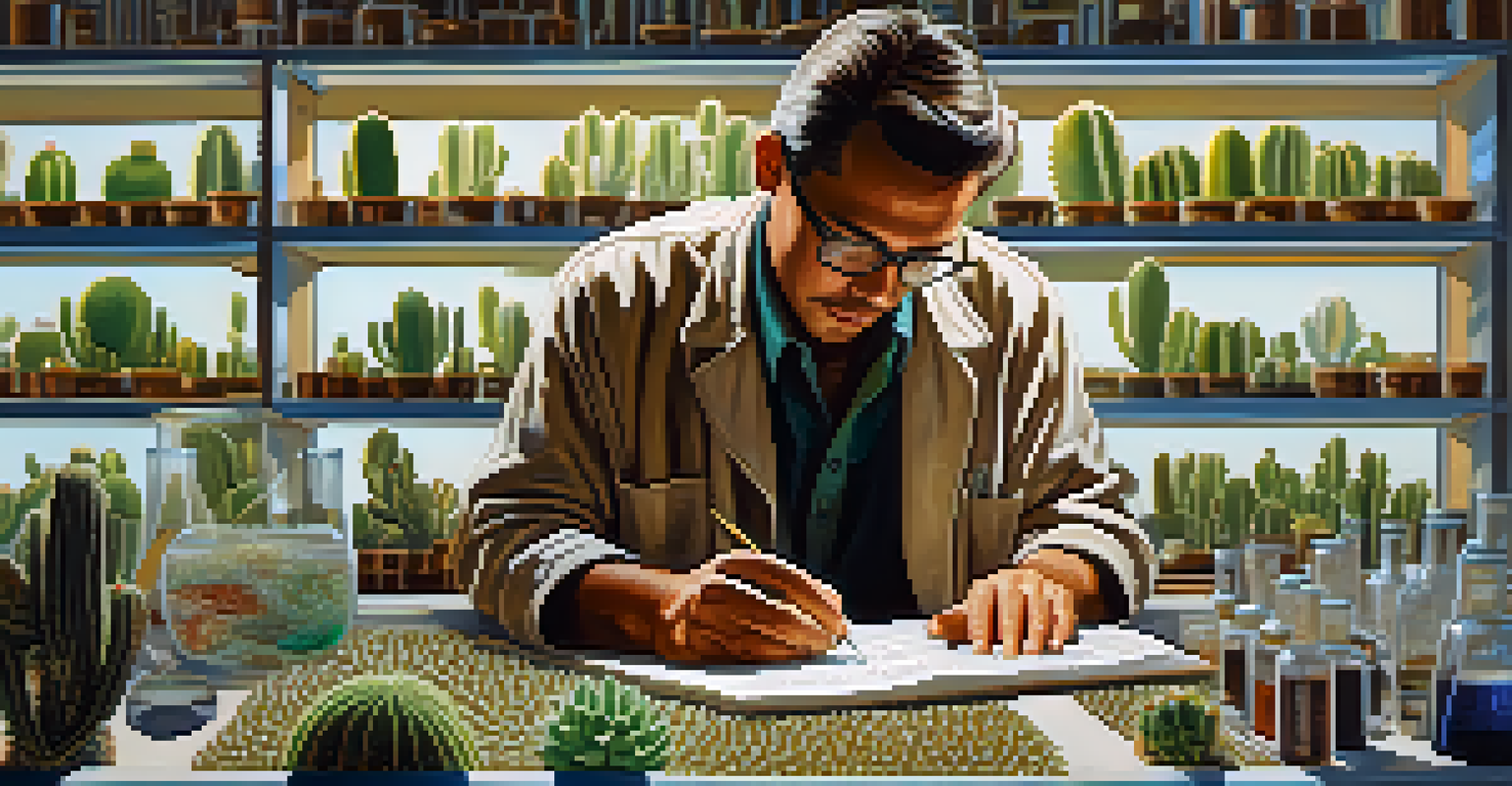Peyote and Mystical Experiences: A Psychological Perspective

Understanding Peyote: A Brief Overview
Peyote, a small cactus native to Mexico and the southwestern United States, has been used for centuries in spiritual and religious practices, particularly by Indigenous peoples. Its psychoactive properties come primarily from mescaline, a compound that induces altered states of consciousness. This unique plant is not just a psychoactive substance; it is deeply intertwined with cultural and spiritual identities.
The experience of peyote can lead to profound insights and a deep sense of connection with the universe.
The use of peyote in traditional ceremonies often aims to connect individuals with a higher power or the universe. Many who partake in these rituals report profound mystical experiences that can lead to lasting psychological insights. Understanding peyote requires acknowledging its historical significance and the respect it commands in various cultures.
Today, peyote is gaining attention in psychological studies, sparking interest in its potential therapeutic benefits. As researchers dive deeper into its effects, the conversation around peyote is shifting from mere recreational use to a serious exploration of its implications for mental health and spirituality.
The Science Behind Peyote and Mescaline
Mescaline, the active ingredient in peyote, is known for its ability to alter perception and induce mystical experiences. When consumed, it interacts with serotonin receptors in the brain, leading to changes in mood, perception, and thought processes. This interaction can open doors to experiences that many describe as transcendent or enlightening.

Research indicates that these experiences often share common themes, such as a sense of unity, profound joy, and deep understanding. For many, these moments can provide clarity and insight into personal issues or existential questions. The brain's altered state during these experiences can foster creativity and emotional healing, providing a unique avenue for personal growth.
Psychoactive Cactus with Cultural Roots
Peyote is a small cactus that has significant cultural and spiritual importance, particularly among Indigenous peoples in Mexico and the southwestern United States.
However, it's essential to approach these effects with caution. The experiences can be intense and may not be suitable for everyone. Understanding the psychological mechanisms at play helps demystify peyote's impact on the mind, allowing for a more informed discussion about its use.
Mystical Experiences: What They Are and Why They Matter
Mystical experiences, often described as profound moments of connection or insight, can be triggered by various means, including meditation, prayer, or the use of substances like peyote. These experiences often involve feelings of unity with the universe, transcendence of time and space, and a deep sense of peace. Understanding these moments is crucial, as they can have lasting psychological effects.
Psychedelics like peyote hold the potential to unlock new avenues for healing and personal growth.
Research suggests that mystical experiences can lead to positive changes in personality, increased well-being, and greater life satisfaction. They often encourage individuals to reflect on their values and priorities, leading to meaningful life changes. Such experiences can also foster a sense of purpose, which is a vital aspect of mental health.
By studying peyote's role in facilitating these experiences, psychologists can better understand their effects on the mind and overall well-being. This exploration has the potential to unlock new therapeutic practices that harness the power of mystical experiences for personal growth.
The Therapeutic Potential of Peyote
As interest in psychedelic therapy grows, peyote is being revisited as a potential therapeutic tool for various mental health issues, including anxiety, depression, and PTSD. Some studies indicate that the introspective and spiritually transformative aspects of peyote can facilitate healing and personal insight. This potential opens new avenues for therapy that blend traditional practices with modern psychological approaches.
Integrating peyote into therapeutic contexts requires a nuanced understanding of both its psychological effects and the cultural significance it holds. Proper guidance and a respectful approach are crucial for harnessing its benefits while minimizing risks. As research continues, the therapeutic community is becoming more interested in the possibility of using peyote in structured settings.
Therapeutic Potential of Peyote
Research is exploring peyote's potential benefits in treating mental health issues such as anxiety, depression, and PTSD.
However, it’s important to remember that the therapeutic use of peyote is still in its infancy. Ongoing studies will help clarify its efficacy and safety, ensuring that if utilized, it honors the traditions that have long respected this sacred plant.
Cultural Perspectives on Peyote Use
Peyote holds a sacred place in the cultural practices of several Indigenous groups, particularly within the Native American Church. For these communities, peyote is not just a substance but a spiritual guide that fosters connection with the divine. Understanding peyote through this cultural lens reveals its deep significance beyond its psychoactive properties.
The rituals surrounding peyote use are steeped in tradition and are often viewed as sacred ceremonies aimed at healing and spiritual growth. Participants engage in prayer, singing, and storytelling, creating a communal experience that fosters connection and understanding. This cultural context is vital for appreciating the broader implications of peyote use.
As modern society begins to explore peyote's psychological aspects, it’s essential to respect and acknowledge these cultural practices. Balancing scientific inquiry with reverence for traditional beliefs is crucial to fostering a respectful dialogue about peyote and its multifaceted role in human experience.
Challenges and Risks of Peyote Use
While the potential benefits of peyote are intriguing, it’s essential to consider the challenges and risks associated with its use. Not everyone will have a positive experience, and some may face psychological distress during or after their peyote journey. Factors such as individual mental health history, setting, and intent can significantly influence the outcome.
Moreover, the legal status of peyote varies widely, with restrictions in many places that complicate its use for therapeutic purposes. These legal barriers can hinder research and limit access for those seeking its benefits. Understanding these challenges is crucial for anyone interested in exploring peyote as a therapeutic option.
Risks and Challenges of Use
While peyote offers intriguing possibilities, its use comes with challenges and risks, including psychological distress and legal restrictions.
As with any psychoactive substance, informed consent and proper support are vital. Engaging with qualified professionals who can provide guidance and care during the experience can mitigate risks and enhance the potential for positive outcomes.
Looking Ahead: The Future of Peyote Research
The resurgence of interest in psychedelics for therapeutic use has sparked a new wave of research into peyote and its effects. As more studies are conducted, we may begin to uncover the full range of psychological benefits that peyote offers. This research will likely contribute to a better understanding of mystical experiences and how they can be integrated into psychological practices.
Additionally, as cultural attitudes towards psychedelics continue to shift, there may be more opportunities for collaboration between traditional practitioners and modern researchers. This partnership could enrich our understanding of peyote's potential while honoring its cultural roots. Such initiatives can pave the way for innovative therapies that blend ancient wisdom with contemporary science.

Ultimately, the future of peyote research holds promise for mental health treatment, but it also carries the responsibility of respecting and preserving its cultural significance. As we move forward, it's essential to approach this exploration with care, curiosity, and respect.